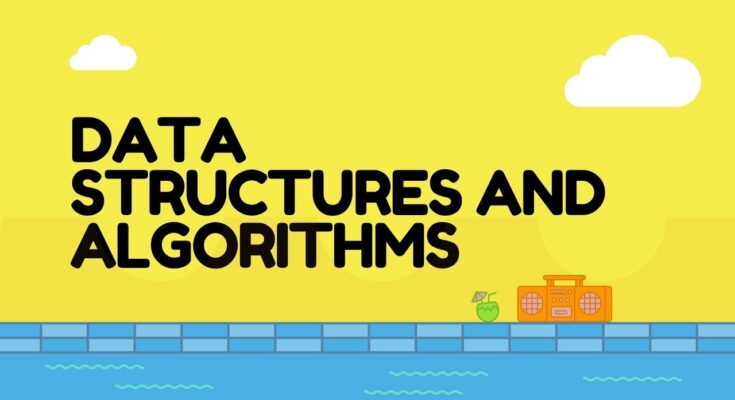Data structures and algorithms are foundational concepts in computer science, serving as the bedrock upon which all software applications are built. These two interwoven topics are essential for organizing, storing, and manipulating data efficiently, as well as for solving complex computational problems. In essence, data structures define the way data is organized and stored, while algorithms provide step-by-step instructions for solving problems and performing tasks using that data.
Data structures can be thought of as the building blocks of a program’s data storage system. They define the relationship between data points and facilitate operations such as insertion, deletion, and traversal. For example, an array is a simple data structure that stores elements of the same type in contiguous memory locations, allowing for efficient random access. On the other hand, a linked list consists of nodes where each node contains a data field and a reference to the next node in the sequence, enabling flexible insertion and deletion operations.
Algorithms, on the other hand, are the procedures or recipes that dictate how data is processed and manipulated. They are the logical sequence of steps that transform input data into the desired output. For instance, sorting algorithms like bubble sort or quicksort rearrange a list of elements into a specified order, while searching algorithms like binary search locate a specific element within a data structure.
A Common–Sense Guide to Data Structures and Algorithms, 2e: Level Up Your Core Programming Skills – BUY NOW
Understanding data structures and algorithms is crucial for anyone aspiring to become a proficient programmer or computer scientist. These concepts not only form the backbone of programming logic but also play a pivotal role in software development, where efficient data management and problem-solving are paramount. Whether you are designing a new software application, optimizing an existing algorithm, or simply seeking to deepen your understanding of computer science principles, a solid grasp of data structures and algorithms is essential.
“Data structures and algorithms are the building blocks of software development, enabling us to create efficient and elegant solutions to complex problems.”
Importance of Data Structures and Algorithms in Computer Science
Efficiency: They are essential for optimizing the use of resources such as time and memory.
Problem Solving: They provide a framework for solving complex problems.
Foundation for Programming: They form the basis for designing and implementing software systems.
Data Structures
Data structures are used to store and organize data in a way that facilitates efficient access and modification. They are essential for managing large datasets and optimizing algorithms.
Types of Data Structures
Arrays
Arrays are a collection of elements stored in contiguous memory locations. They allow for random access to elements based on an index.
Linked Lists
Linked lists are a collection of elements, each containing a pointer to the next element in the sequence. They are flexible in size and allow for efficient insertion and deletion operations.
Stacks
Stacks are a last-in, first-out (LIFO) data structure, where elements are added and removed from the same end. They are used for managing function calls, undo mechanisms and expression evaluation.
Queues
Queues are a first-in, first-out (FIFO) data structure, where elements are added at the rear and removed from the front. They are used for managing tasks in a sequential manner.
Trees
Trees are hierarchical data structures consisting of nodes connected by edges. They are used for organizing data in a hierarchical manner and are commonly used in file systems and databases.
Graphs
Graphs are a collection of nodes connected by edges. They are used to represent relationships between objects and are used in social networks, maps, and network routing algorithms.
Operations on Data Structures
Traversing
Traversing a data structure involves visiting each element in the structure exactly once. It is used to access or process the elements in a specific order.
Searching
Searching involves finding a specific element in a data structure. Common searching algorithms include linear search, binary search, and depth-first search.
Insertion
Insertion involves adding a new element to a data structure. The insertion operation can vary in complexity depending on the type of data structure.
Deletion
Deletion involves removing an element from a data structure. Like insertion, the complexity of deletion depends on the type of data structure.
Examples of Data Structures in Real Life
Arrays: Shopping lists, arrays of seats in a theatre.
Linked Lists: Train cars connected to each other.
Stacks: Piles of books, and plates in a cafeteria.
Queues: Waiting in line at a ticket counter.
Trees: Family trees, organization charts.
Graphs: Social networks, road networks.
Algorithms
Algorithms are step-by-step procedures for solving problems or accomplishing tasks. They are fundamental to computer science and are used in various applications.
Types of Algorithms
Sorting Algorithms
Sorting algorithms arrange elements in a specific order, such as ascending or descending. Common sorting algorithms include bubble sort, insertion sort, and quicksort.
Searching Algorithms
Searching algorithms find the location of a specific element within a data structure. Common searching algorithms include linear search, binary search, and hash tables.
Graph Algorithms
Graph algorithms operate on graphs to solve problems such as finding the shortest path, determining connectivity, and detecting cycles.
Greedy Algorithms
Greedy algorithms make locally optimal choices at each step with the hope of finding a global optimum. They are often used for optimization problems.
Dynamic Programming Algorithms
Dynamic programming algorithms break down a problem into smaller subproblems and solve each subproblem only once, storing the results for future use.
Characteristics of a Good Algorithm
Correctness: The algorithm should produce the correct result for all valid inputs.
Efficiency: The algorithm should use the minimum amount of resources, such as time and memory.
Ease of Understanding: The algorithm should be easy to understand and implement.
Examples of Algorithms in Real Life
Sorting Algorithms: Sorting a deck of cards, organizing a list of names alphabetically.
Searching Algorithms: Finding a book in a library, searching for a contact in a phone book.
Graph Algorithms: Finding the shortest path between two locations on a map.
Greedy Algorithms: Making change with the fewest coins.
Dynamic Programming Algorithms: Calculating Fibonacci numbers.
Also Read: How to Learn CSS as a Beginner?
Relationship Between Data Structures and Algorithms
How Algorithms Use Data Structures?
Algorithms use data structures to store and manipulate data. The choice of data structure can significantly impact the efficiency of an algorithm.
How Data Structures Impact Algorithm Efficiency?
The efficiency of an algorithm depends on the data structure used. For example, using an array for searching can be faster than using a linked list due to its random-access capability.
Conclusion
In conclusion, data structures and algorithms are the fundamental building blocks of computer science and programming. They are essential tools for organizing, storing, and manipulating data efficiently, as well as for solving complex computational problems.
A thorough understanding of data structures and algorithms is crucial for anyone involved in software development, from beginners to experienced professionals. These concepts not only form the foundation of programming but also play a vital role in optimizing the performance of software applications.
By mastering data structures and algorithms, programmers can write more efficient and scalable code, leading to faster and more reliable software. Additionally, a deep understanding of these concepts allows developers to choose the right data structures and algorithms for a given problem, leading to more elegant and effective solutions.
In essence, data structures and algorithms are the building blocks of modern computing. They enable programmers to create sophisticated software applications that can process vast amounts of data and solve complex problems with ease. As technology continues to evolve, the importance of data structures and algorithms in computer science will only continue to grow, making them essential knowledge for anyone pursuing a career in technology.
FAQ
Q: What are data structures?
Data structures are a way of organizing and storing data in a computer so that it can be accessed and modified efficiently. They define the relationship between the data and how operations can be performed on it.
Q: What are algorithms?
Algorithms are a set of step-by-step instructions for solving a specific problem or performing a specific task. They take input, process it, and produce output in a finite amount of time.
Q: Why are data structures and algorithms important in computer science?
Data structures and algorithms are fundamental concepts in computer science because they enable programmers to write efficient code. They are essential for managing large datasets, optimizing algorithms, and solving complex problems.
Q: What are some common types of data structures?
Some common types of data structures include arrays, linked lists, stacks, queues, trees, and graphs. Each type has its own advantages and is suitable for different types of problems.
Q: What are some common types of algorithms?
Some common types of algorithms include sorting algorithms (e.g., bubble sort, quicksort), searching algorithms (e.g., linear search, binary search), graph algorithms (e.g., depth-first search, breadth-first search), and dynamic programming algorithms.
Q: How are data structures and algorithms related?
Data structures and algorithms are closely related because algorithms often use data structures to store and manipulate data. The choice of data structure can significantly impact the efficiency of an algorithm.
Q: What is the importance of understanding data structures and algorithms for programmers?
Understanding data structures and algorithms is important for programmers because it allows them to write efficient code that can handle large datasets and solve complex problems. It also helps them to analyze and optimize existing algorithms for better performance.
Q: Where can I learn more about data structures and algorithms?
There are many resources available online and in books that can help you learn more about data structures and algorithms. Websites like Khan Academy, Coursera, and edX offer free courses on these topics. Additionally, there are many books available on Amazon and other online retailers that cover these topics in detail.




